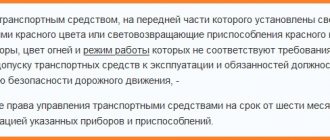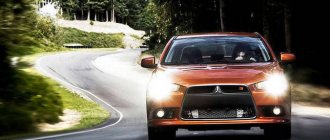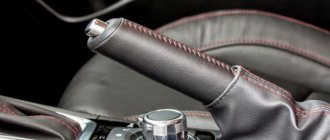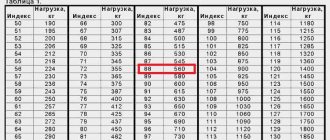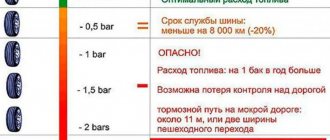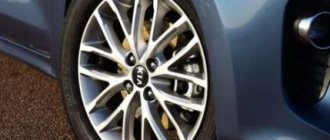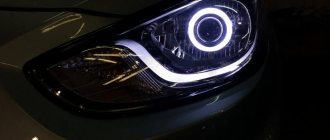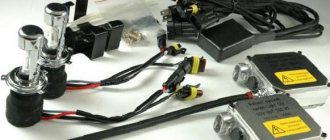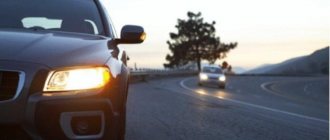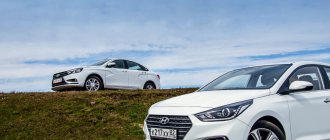In today's article we will look in detail at whether it is possible to install xenon in fog lights. Can we first explain what this technology is?
Xenon-based gas-discharge lamps operate without an incandescent filament. Two electrodes are placed inside the flask, and the container itself is filled with xenon gas. With the help of special ignition units, a high voltage is created between the electrodes, from which the gas begins to shine brightly.
The power of the luminous flux is much greater than the usual glow from halogen bulbs. At the same time, xenon optics can operate up to 3 thousand hours, practically does not heat up, and does not place a large load on the generator.
Let us remind you that our topic today is whether or not to install xenon in fog lights. The main purpose of any automotive optics is to create conditions for good visibility while driving, under any adverse conditions: fog, slush, rain, snow, twilight, night, etc. Xenon headlights in foglights, when installed correctly, can “break through” any obstacles. They perfectly illuminate the road surface and the surrounding area, creating a normal overview. Thus, xenon reduces the risk of traffic accidents and other emergency situations, helping to improve safety.
Moreover, such optics look very presentable. Bright blue-white light can improve the appearance of a car, giving it a somewhat cosmic appearance. Many car owners, in an attempt to “pump up” their car, voluntarily try to install xenon lights instead of halogens in their fog lights. However, excessively bright or incorrectly adjusted xenon headlights can blind oncoming drivers, which will negate all their potential benefits.
Is it possible to install xenon lamps in fog lights?
According to current Russian legislation, it is prohibited to drive with xenon foglights if it is not installed in a given car as standard.
What does “as usual” mean? That is, such lamps in fog lights are provided by the manufacturer. Each manufacturer approves a certain type of lamp for a car, which is regulated by special markings. Also, the bulbs must match the headlights. To understand whether it is possible to install xenon in your fogs, you need to clarify this data in the PTS or EPTS.
If your headlights are not originally (standard) designed for xenon, a car inspector or technical inspection inspector can and has the right to punish you. By the way, very harsh!
According to Part 3, Art. 12.5 of the Code of Administrative Offenses of the Russian Federation, this violation is punishable by deprivation of rights for 6-12 months.
The xenon headlight markings are as follows:
- DC – can be installed in low beam headlights;
- DR – can be set to high beam;
- DCR – can be set to both modes.
Fog lights do not belong to head optics; they are considered additional light. However, this does not mean that there are no markings for them. All external lighting equipment that allows the installation of gas-discharge lamps, which includes fog lamps, must have an abbreviation beginning with the Latin “D”.
Next, in order to finally figure out whether xenon is allowed in fog lights, let’s turn to the Technical Regulations of the CU “On the safety of wheeled vehicles.”
Here are the excerpts we found in the 465-page Talmud:
- Clause 3.4 of the Basic Provisions for Vehicle Approval states: it is prohibited to install lenses and lamps on lighting devices that do not correspond to the type of equipment;
- According to clause 1.3. The marking of headlights and additional optics and the class of light sources embedded in them must correspond (that same letter D);
- In the same section. Adaptive lighting systems, including foglights, with a nominal luminous flux of more than 2000 lumens must be equipped with an auto-corrector for adjusting the headlight angle.
Almost all modern gas-discharge lamps have a luminous flux that exceeds this standard. That's why you can't put them at random.
Where installation is allowed
In order not to redo the work and not to become a “victim” who has been reported due to the incorrect use of xenon in fog lights, you should initially buy “legal” lamps, the requirements for which we have listed in the previous paragraphs. And after that you need to start installing them correctly.
Self-installation of xenon lamps should be excluded immediately, if only because of safety precautions for human life. Their installation should be carried out by specialists.
It is best to contact trusted service stations that can carry out this task efficiently and without harming the appearance of the vehicle, which is also important.
Installation in the front of the car is permitted only for white and yellow light lamps according to the following parameters:
- vertical placement, the distance from the plane of the side dimension should not exceed 400 mm from the outer edge of the diffuser;
- horizontal placement - the distance from the bottom edge of the diffuser is 250 mm.
It should be borne in mind that xenon lamps are brighter than halogen lamps, so the safety of operating a vehicle will directly depend on the correct placement of headlights with such lamps.
Even ten millimeters can be fatal if the light hits the earth's surface at the wrong angle.
Fog lights are an optional optical means in a car, so during production they are not installed in all models, like the main high beam and low beam.
But if the vehicle is operated in an area with difficult weather conditions, then the motorist can install them.
If the choice falls on xenon lamps, then before installing them you should study the regulations of the legislation, standards, and choose the right certified products.
Such formal actions will facilitate compliance with the rules of safe movement, first and foremost. And after that they will allow you to avoid administrative penalties for offenses.
The peculiarity of PTFs is that they should be used in front of the car with only yellow or white light, and most importantly, they should be mounted in the right place.
When using xenon lamps, caution regarding such requirements should be as high as possible, because their light is much brighter than that of their halogen counterparts, so their operation should be taken several times more carefully.
How to install xenon in reverse with your own hands is described in the article: xenon in reverse.
How to check the xenon ignition unit, see the page.
Find out about the sale and installation of xenon in Moscow from this information.
Is it necessary to install a washer and auto-corrector?
So, we found out whether xenon is allowed in fog lights (ptf). If gas-discharge lamps are not provided by the manufacturer, they cannot be installed without permission.
Auto-corrector is also required, because there is no point in installing lamps with a flux intensity of less than 2000 Lm in fog lights - you will not achieve good visibility.
Why do you need to install an additional washer or headlight cleaner? A layer of dirt on your headlights will inevitably affect the intensity of the light as well as its directionality. Under high-power conditions of a gas-discharge lamp, ice and dust on the fins of the headlight will distort the beams. As a result, even a correctly configured lamp can blind oncoming drivers.
Recommendations
By installing xenon on the car, fog lights can also be “upgraded” if necessary
However, it is important to remember that increasing the brightness of the glow will require the owner not only to follow all the recommendations discussed above, but also to more carefully adjust the optics. Also, during operation, the auto adjustments of the head optics and PTF must be checked on a special stand or periodically adjusted the light with your own hands.
An equally important criterion is the choice of the color of the xenon lamps. At the same time, yellow colors are best suited for PTF, but do not combine well in terms of appearance with xenon in the headlights. At the same time, white and blue xenon improve the appearance of the car, but illuminate the road noticeably worse in fog, rain or snow.
When it comes to installation, many unskilled installers try to place the ignition units closer to the headlights. In the case of PTF, this cannot be done, since the fogs are located close to the road, constantly suffering from moisture. For this reason, you need to select long wires in advance in order to place the blocks away from the fogs.
Also, when purchasing xenon PTF, it is better to choose kits with thin ignition blocks (slim block). Adjusted for the lower power of the foglight, xenon will work quite normally with a thin block. Such ballast is easier to install under the hood, especially considering the presence of two more ignition units for headlights. At the same time, experienced car enthusiasts usually install blocks for headlights of a standard size.
More about punishment
If a car owner, knowing whether it is possible to install xenon in fog lights (ptf), installs them without permission, despite the ban specifically for his car, he may be punished. By the way, ignorance of the law also does not exempt you from responsibility.
But there are a number of nuances here.
- The fog light is not the main light, so you don’t have to turn it on at all. If it was not lit at the time the traffic inspector stopped it, you have the right to refuse to activate it, explaining that there is no good reason to fulfill this requirement;
- Even if you were stopped when the PTFs were on, and the traffic police officer suspected that the lamp was running on xenon, how would he be sure that the markings do not match? You have the right not to allow the integrity of the car to be violated and not to allow him to unscrew the light bulb.
However, a traffic police officer has the right to check your car for compliance of its optics with legal regulations when stopping at a stationary checkpoint. In this case, the inspection is performed only by an accredited technical supervision inspector. If you find yourself in these conditions, prepare for severe punishment, including deprivation of your license for at least six months.
Why so strict? Because, by unauthorizedly installing xenon in the foglights, on a car for which this is not provided, you have made illegal changes to its design.
Is it possible to avoid responsibility?
The requirements for lighting devices are described in Article 12.5 rather vaguely, so the punishment can often be mitigated - instead of depriving the driver of his license, the driver will only have to pay a small fine of 500 rubles. To do this, you need to present arguments that will indicate that it was not the third part of Article 12.5 that was violated, but the first - the punishment for such a violation will be much lighter. But in many respects the outcome will depend on the decision of the judge, so it is better not to break this rule and not bring the matter to trial.
Is it worth installing xenon in foglights?
Above we explained whether it is possible to install xenon in the PTF, and now we will discuss whether this is worth doing at all. There is no need to even discuss standard placement here - at the factory, lighting devices are adjusted correctly and as correctly as possible. In this case, you will not find any negative factors in the operation of gas-discharge lamps. However, if you install them yourself, as a result of incorrect settings, you may not only not feel the benefit, but even cause harm to yourself and others.
- The light from xenon inevitably scatters in all directions, while fog lights must shine downward to create a good view. It is extremely difficult to set the upper limit of light distribution in xenon fog lights, namely, what gives visibility in fog. Especially on Chinese xenon sources. As a result, instead of the road surface, you will see a white wall. And this is unsafe and pointless.
- Moreover, such light will blind both oncoming drivers and those driving parallel to you through the mirrors.
- And one moment. Fog lights, as you know, are located low on the body. In this position, bright light, even with the slightest unevenness of the road surface, creates strong shadows. As a result, the driver feels that there are deep holes ahead, so he drives slowly and irrationally.
That is why it is so important to correctly focus the light beams, direct them correctly onto the road surface and to the side, which is only possible in normal mode.
Well, we hope we have given a comprehensive answer to the question of whether xenon is allowed in fog lights in 2022. Our opinion, by the way, coincides with the normative-legal one. Replace xenon with LEDs or install good halogens. The first ones provide the necessary pleasant diffused light, by the way, no less bright, while the second ones are time-tested.
Let's sum it up
Fog lights are very effective in poor visibility conditions and have positive qualities that headlights do not have. Fog lights shine low, their light literally spreads along the road and provides excellent visibility in the area of the nearest 10-15 meters. Another positive distinctive quality of PTFs is that they provide a clear cut-off line, which seems to cut through the fog and allows the driver to better navigate the road and assess the distance to obstacles. But!!! If your car has xenon installed in the PTF, you will most likely be deprived of all of the above benefits! Bright, unregulated xenon in the fog lights shines anywhere - on birds, illuminates the side of the road, blinds oncoming cars, but not under your own wheels. Before installing xenon in fog lights, think carefully and take into account the above. If you don’t want to have problems with traffic police officers, don’t want to be deprived of your license, and you don’t give a damn about other road users, refrain from installing xenon in fog lights. If you really want to install xenon bulbs, then entrust this work to a professional who will not only select the right bulbs of the required power, but upon completion of the installation work will adjust the PTFs so that they do not blind other motorists and are as effective as possible for you.
Sources
- https://KrutiMotor.ru/ksenon-v-protivotumanki/
- https://asx-club.su/doityourself/ustanovka-ksenona-v-protivotumanki-cto-nuzno-znat.html
- https://AutoTonkosti.ru/q/mozhno-li-stavit-ksenon-v-protivotumannye-fary
- https://LampaExpert.ru/avtomobilnye-lampy/ksenon/ustanovka-v-protivotumanki-razreshen-ili-zapreschen-lishenie-prav-shtraf
- https://electro-kot.ru/kak-ustanovit-ksenon-v-protivotumanki.html
- https://autolab24.ru/mozhno-li-stavit-ksenon-v-tumanki-po-zakonu/
- https://avtopravozashita.ru/ksenon/razreshen-ili-net-ksenon-v-protivotumankah.html
- https://avtodigitals.ru/mozhno-li-stavit-ksenon-v-protivotumanki/
- https://svetilnik.info/avtomobilnyj-svet/mozhno-li-stavit-ksenon-v-protivotumanki.html
- https://farainfo.ru/mozhno-li-ustanavlivat-ksenon-v-protivotumanki-chem-grozit-ustanovka-ksenona-v-ptf/
When to use fog lights?
So, you can’t install xenon in fog lights, let’s mark a point at this point. Finally, let’s discuss when it’s okay to include these sources:
- In the dark on an unlit road, paired with low or high beam headlights;
- When stopping or parking for a long time in a dark place or in bad weather conditions;
- If you are driving in fog or in rain/snowfall, paired with low or high beam lights;
- Instead of daytime running lights during the day. It can also be used instead of low beam headlights during the day.
Our article has come to the end; we have explained in what cases xenon can be used in fog lights, and what the consequences of violating these requirements are. Instead of a conclusion, let's speculate.
People try to install xenon lamps in fog lights to achieve high intensity light rays. In order to improve visibility in dense fog conditions. However, not everyone understands that simply screwing in a gas-discharge light bulb is not enough. It is important to properly configure the headlights, equip the optics with additional options, and, ultimately, purchase high-quality lamps that will not exceed the permissible luminous flux. Without these conditions being met, xenon in fog lights will play the role of a useless, stupid, and even dangerous assistant for other road users.
Features of PTF operation
Fog lights can be part of the head light or a separate element of car optics; they are located on the bumper or under the head light. The key requirement for such lighting devices: they must emit the same white or rich yellow wide beam of light over the road. The design feature is related to the requirement to ensure good visibility in difficult weather conditions: thick fog, precipitation, etc.
- in rainy weather, the light from the PTF does not scatter, does not reflect or crystallize;
- when it snows, the light does not reflect off the white canvas and does not crystallize;
- in fog, the light beam lies between the road and the fog and provides good visibility of the road surface.
